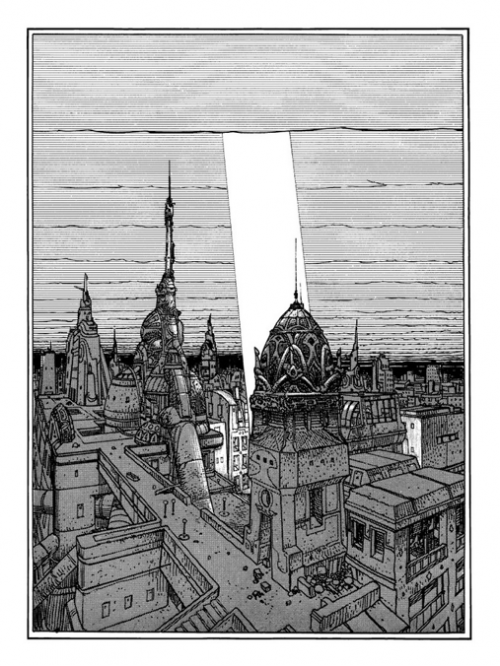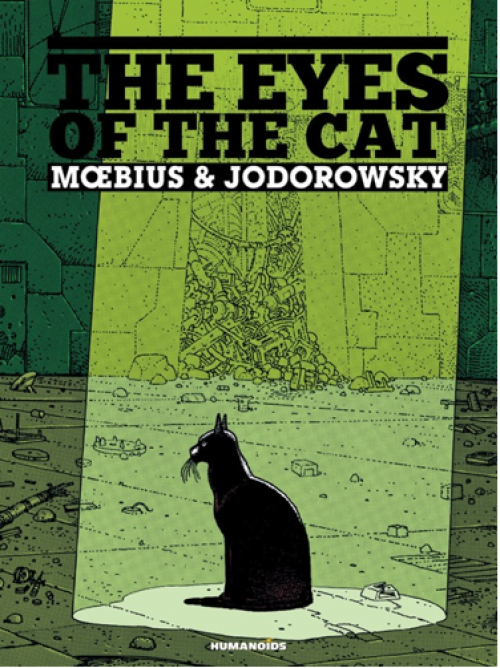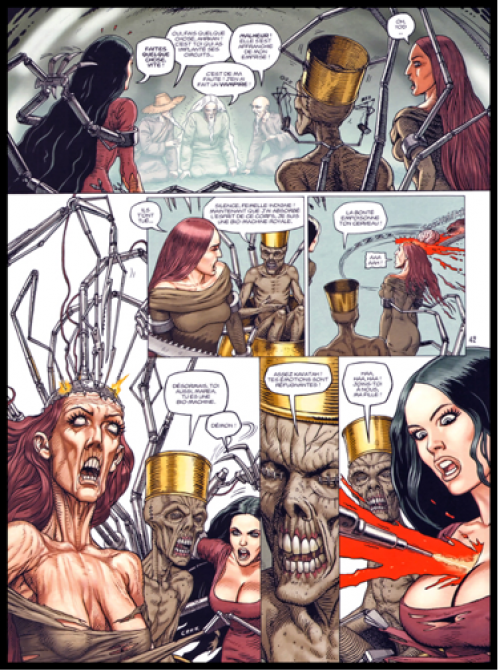

Animal Cruelty and enormous breasts, or: more fun with Alejandro Jodorowsky

Recently I reviewed The Incal, the epic psychedelic space opera from the all-round holy madman Alejandro Jodorowsky and French comics master Moebius. It is, as I said, good to a consciousness-scrambling degree. But Jodorowsky has many other works available in English, and today I draw attention to two of them, one of which dates from the beginning of his comics career and the other of which appeared at what we must assume is close to the end of it, given that he is now 83. Connoisseurs of lunacy take note.
Eyes of the Cat was not Jodorowsky’s first comics work- he had written and illustrated strips published in Mexico in the 1960s- but it was his first big splash in the French market where he was to make his living after the collapse of his film career in the late 70s. Like The Incal, it is a Moebius collaboration, and was originally released in digest size on garish yellow paper as a freebie by the French publisherLes Humanoides Associes, to reward subscribers to their trippy SF magazineMetal Hurlant. It soon became a collector’s item, changing hands for lots of money, and has been released in numerous iterations over the last thirty years. In English it first appeared on yellow paper inside the long defunct horror anthology Taboo, and then twenty years later was reissued by the LA-based arm of Les Humanoides in an incredibly expensive luxury format that sold out in approximately 20 seconds (or something like that). Now Eyes of the Cat is back again, this time in tabloid size on heavy white paper stock.
Alright, you format fetishist, but what’s it about? Well it’s difficult to explain because the story is so short and simple that the briefest description risks giving the game away. In his introduction, Jodorowsky explains that Moebius himself complained that there was only enough content for a five pager, not an entire book. Jodorowsky’s solution was to take each panel and treat it as a full-blown illustration, faced each time by an (almost) static panel of a boy standing in a tower in silhouette with his back to us. Et voila! You have a fifty page book.
And now, the “plot”: in a seemingly abandoned city that is rotting and crumbling, a cat emerges from the shadows to stretch itself in a lone beam of sunlight. At the order of the boy in the tower, Meduz the Hawk attacks. I won’t tell you what happens next, although I will say that what on the surface seems like gross-out horror is actually a dense, resonant, symbolic something-or-other that feels a little like a poem, a little like a parable, a little like a riddle, and a little like an isolated sequence from a long nightmare. Very few words are used, and although the new translation is much more poetic than the original cheesy yellow paper version in Taboo, I am not at all certain that it is an improvement.

Fortunately this doesn’t really matter: Jodorowsky is a trained mime, and the words are barely necessary. Meanwhile the story is so beautifully drawn that you can return to it again and again, for Eyes of the Cat is truly a thing of beauty, an object to be lingered over at length, located somewhere on the border of comics and fine art, as if Albrecht Durer had reemerged to work in the unlikely milieu of late 70s pessimistic French-Chilean mystical sci-fi horror (but let it stay on the border, and not cross over into that dreary other world, please). Indeed, so delighted was Jodorowsky with Moebius’ work that he tells us that every evening he would drive thirty miles each way from his house to Moebius’ place to see each finished panel, with the result that he dedicated “1500 miles of hours on the road in honour of “The Eyes of the Cat”.” It’s a fitting tribute.
So that was Moebius and Jodorowsky’s first collaboration; but after Eyes of the Cat came hundreds of pages in the form of The Incal and The Madwoman of the Sacred Heart while Jodorowsky produced thousands more pages with other artists, hopping from genre to genre, blending the sacred with the sexual and scatological, the divine with the absurd. And thus thirty years later we find ourselves staring at the strange creature that is Megalex – a collaboration with artist Fred Beltran, the majority of which was drawn on computer, and which is as dense and overblown as Eyes of the Cat is sparse and minimal.
Megalex is the story of a planet where the permanently stoned citizens live in an entirely man made environment, entertained by cruel spectacles, and where “anomalies” are exterminated without mercy. Dig the satire, man. Unlike the sparse and minimalistic Eyes of the Cat it is written in Jodorowsky’s much more familiar overdriven style, whereby a profusion of mad ideas are crammed into each panel; plot twists and deus ex machinas are thrown around with abandon; and a scurrilous sense of humor collides with an ultimately overwhelming undercurrent of New Age mumbo-jumbo. There are freaks, colossal breasts, robots, mutants, wicked parents, an underground resistance struggling against evil and then (as the art switches from computer-generated to hand-drawn) a great deal of spiritual enlightenment and soul-healing.

The problem with Megalex is that much as it is mad, it is in many ways derivative of the first book of The Incal: the drug-addled populace in an entirely artificial environment; a sub-class of freaks; and an androgyne that heals, all appeared in one form of another in the earlier series, but unlike that psychedelic epic, Megalex does not explode outward in every direction. Rather, the third section feels very rushed, as if Jodorowsky and Beltran had originally planned to extend the story over multiple volumes but suddenly decided to tie up all the loose ends very quickly. The result is a fairly flat parable about man and nature and male and female principles living in harmony that feels almost- shockingly- conventional. It is still Jodorowsky, so it is by no means boring or otiose, though it sits far down the list of “essential” works.
But do the early masterpiece and the late period minor work have anything in common? They are separated by decades, split asunder by tone, content, genre, artists, nearly everything you can think of. And yet both posit weird future environments, dead worlds without vegetation or organic life, populated by children without parents, who are searching for some kind of wholeness. In Eyes of the Cat even the clothes of the boy are rotting, while his skin (in an area of great significance for the plot) is cracked and crumbling. He is young without youth; how long has he been standing in the tower? What does he eat, how does he live? In Megalex we meet an ancient, wizened, inhuman king who has cursed his own daughter to a form of eternal life that denies her human contact; though she seems young, she is in fact ancient, a prisoner of her own flesh. But whereas in Megalex the regeneration comes and is completely unpersuasive, in Eyes of the Cat it is denied. There is only decay, violence, death, and a futile game, forever and ever, amen. Although at one point Jodorowsky was talking about writing a sequel…
Latest posts by Daniel Kalder (Posts)
- Book Review: Retroworld (plus, why I hate Star Trek) - April 3, 2014
- A very expensive fungus - October 16, 2013
- The secret rituals of history’s most creative minds - October 9, 2013
- Apparently we are all getting very old - October 3, 2013
- Vasily Grossman: from Stalingrad to toilet trouble - August 28, 2013
 Print This Post
Print This Post




I remember first encountering Eyes of the Cat in Bissette’s very good Taboo anthology– as part of a Jodorowsky retrospection/introduction which also featured some of Spain Rodriguez’s comics adaptation of El Topo (which I don’t think was ever completed, or only a few pages were created for promotional purposes, or something, I could probably dig out my copy and check). Also, I believe there was an interview with Jodo in which he said something about Mr. Fantastic stretching his penis until it was long and thin enough to travel through the Invisible Woman’s veins and he could ejaculate into her heart.
I agree RE: Megalex. Jodo has a tendency to revisit the same themes/images — for instance, severed limbs, tattoos, spiritual enlightenment, fart jokes, incest, rape, androgyne, cultism. It’s all in the presentation, and I don’t think he presented it as well in Megalex as in most of his other works. A big part of the problem for me was the artwork, which I thought showed a lot of skill, but I found it really artificial and off-putting, especially in the beginning. I understand thematically what they were going for, The artificiality of it ended up bleeding into the story, or vice versa. Nothing about it felt natural to me — almost like Jodo and Beltran were trying too hard to be “Jodorowskian.”
The Jodorowsky “bonus material” in that Taboo anthology is exceptionally good- worth the price of admission alone. And I think you’re right about Megalex, it throws a lot of stuff into the pot but never quite takes off. I didn’t mind the artificiality of the art so much though, I found it interesting to look at.